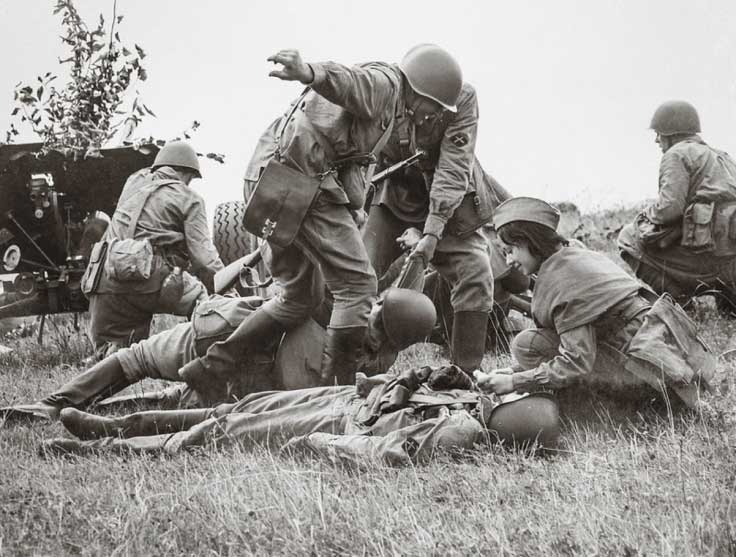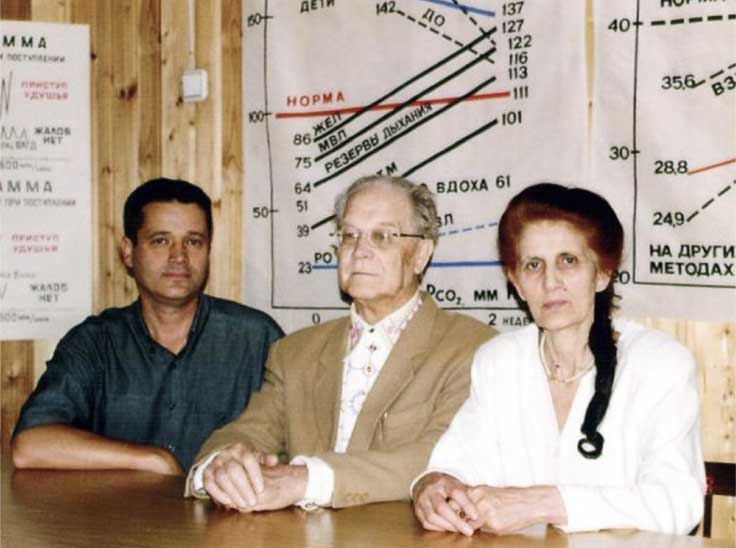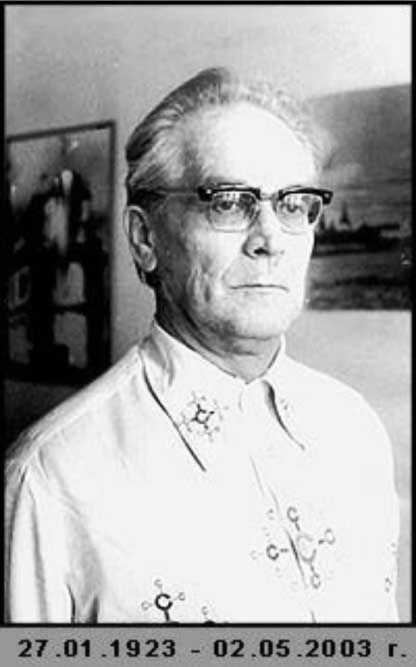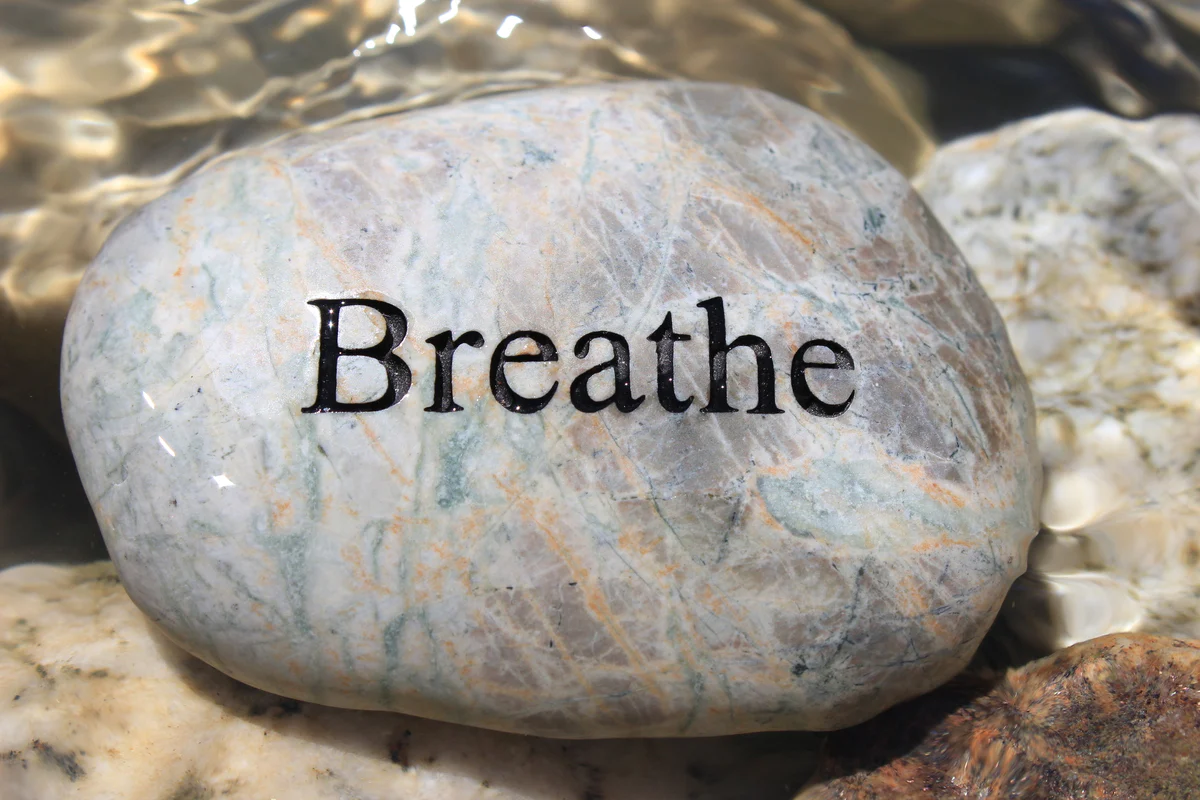
Biography Of
Doctor K.P. Butekyo
“An ordinary boy with extraordinary capabilities”
Konstantin Pavlovich Buteyko was born in 1923 in a small village near Kyiv, Ukraine. As a child, he would spend hours quietly observing and examining plants, insects, and anything else he encountered. His father was a mechanic, and the boy also liked learning about vehicles. His mother, a schoolteacher, was known to say, “I gave birth to an odd boy,” referring to her son’s avid curiosity about understanding how things work.
Buteyko saw any mechanism as an intriguing collection of parts and would be tempted to take them apart. Growing older, he became fascinated by the idea that it is not only the parts that make things work smoothly but the interaction between them—the balance of a system as a whole supported by certain constants. This natural progression led him to the Polytechnic College in Kyiv where he began studying engineering.

“War experience inspires Dr. Buteyko to pursue medical studies”
During his sophomore year, in 1941, German fascists attacked the Soviet Union. Buteyko enlisted and volunteered to go to the frontlines. He spent the next four years in the war zone working as a driver, mechanic, and helper in a medical aid party. He saw many vehicles damaged in battle and was able to fix them. He also saw many human casualties and was frustrated that he did not have the skills to save people’s lives. He viewed the human body as the most superior of all machines, and finding ways to help it operate in the most effective way became his new goal. He decided to study medicine.

After the war, Buteyko enrolled at First Medical Institute in Moscow, Russia. He was an outstanding student, and soon became known as the handsome young veteran with a sharp intellect and abundant energy—and the highest grades. He spent most of his time studying at the library or conducting clinical work. Upon graduating with distinction, he was invited to join the staff at one of Moscow’s most elite hospitals. His scientific and clinical supervisors, as well as his friends, were convinced that a bright future was beginning to unfold for this talented doctor.

“How the Buteyko Method was born?”
While still in medical school, Buteyko had specialized in the study of hypertension (also called high blood pressure). Ironically, Buteyko himself developed a malignant form of this, in this case, lethal disease. The hospital whose staff he had joined prescribed him the best medicine available for the treatment of this illness, but his condition only worsened. In the fall of 1952, his health had deteriorated to such a degree that it seemed unlikely he would live for more than a couple of months. Dr. Buteyko was a man of great strength and fortitude who, despite tremendous pain, continued working.
One evening, during his night shift at the hospital, he was alone in a room, standing in front of a window and looking up at a star-filled sky. His mind was racing with questions: “What is the cause of my disease? Why do people become ill?” Suddenly, a blinding light flashed outside and he lowered his gaze to shield his eyes. Looking downward to regain his vision, he suddenly noticed that his chest and belly were moving a great deal as he was breathing. It was common medical knowledge that heavy breathing was a symptom of hypertension, but at this moment, Konstantin had an idea, which later he described as odd: “Could it be,” he thought, “that my heavy breathing was not the result of my disease but the cause of it?”
Ever the indefatigable scientist, he immediately began experimenting on himself. First, he decreased his breathing by making an effort to breathe gentler. Within a few minutes, his headache, and the strong pain in his chest and kidneys that had always accompanied him began to subside. Second, he increased his breathing by switching to heavy mouth breathing. His pain came back almost immediately. This was a pivotal moment for Buteyko, one that would change the course of his life.

Many years later, he stated that within these first minutes of discovery, the whole chain of cause and effect appeared before his eyes. He thought, “Over-breathing eliminates CO2 from the body and consequently creates contractions of bronchi, blood vessels, intestines, and so on. These spasms reduce oxygen delivery to the body, causing oxygen starvation. This increases respiration, even more, creating a vicious circle.” It immediately became clear to him that many diseases associated with the contraction of blood vessels such as high blood pressure, coronary artery disease, heart attack, stroke, ulcer, chronic nephritis, and others have a single cause: over-breathing. His thought process continued: “Then, hyperventilation changes pH — the acid-base balance — and causes a disturbance of metabolism. Dysfunctional metabolism transmits immune reactions into allergic, which tells us that allergy could also be caused by hyperventilation, as well as high cholesterol, obesity, or thinness. It also weakens immunity, and thus, people catch colds and other, more serious diseases. A metabolic disorder can become so severe that a tumour will develop. This means that even cancer could be caused by deep breathing.”
That night he went to the pulmonological department of the hospital where an asthmatic, fighting suffocation, was trying to gasp as much air as possible.
“Slow down your breathing and breathe less!” Buteyko suggested.
“…but doctor, you’ve always told me, ‘Take a deep breath!’“
“I know; I was wrong. Please breathe gentler,” Buteyko insisted.
After a few minutes of slowed breathing, the patient was able to breathe better and his face regained some colour. The asthma attack receded. Both men were surprised by how quickly it was defeated.
“Buteyko realized that many diseases can be cured by reducing one's breathing, but the idea was just too simple for other medical officials to accept...”

Of course, Buteyko was excited by his finding and wanted to enlighten the whole world about it. He knew how tremendously beneficial it would be for people! The next morning, he went to his clinical and academic supervisor and revealed his remarkable discovery. The physician listened carefully but his reply was not what Buteyko expected: “Don’t tell anyone,” the doctor insisted, “or you will end up in a mental institution.” Stalin was still holding power in Russia and had recently sent many doctors to the Gulag on forged grounds for arrest. His supervisor truly cared about this talented doctor and wanted to protect Buteyko’s life. He immediately recognized that his ground-breaking discovery would question the very basis of traditional medicine and make many officials merciless.
But the young doctor was not the type to give up easily. First, he tried his new approach himself. Breathing reduction eliminated his malignant hypertension and he fully regained his health. Then, he proceeded to test his method on his patients at the hospital. He discovered the result was consistently positive. When his patients increased their breathing, their symptoms worsened. When they reduced their breathing, their symptoms receded and their health improved. By modifying the breathing patterns of his patients, Buteyko was able to achieve much greater results than when he treated them with traditional medication. Additionally, his method did not have any negative side effects. And yet, he could not reveal the results of his work.

It was during this time of personal trial that Dr. Buteyko compared the path of his discovery to that of the Austrian physician Ignaz Semmelweis. In 1847, Semmelweis discovered that sepsis occurring during childbirth in hospitals could be radically reduced by washing hands. At the time, doctors would often switch between dissecting corpses and assisting women in labor without washing their hands. The mortality rate of infants and mothers was incredibly high. Dr. Semmelweis believed that it was possible to reduce it by simply requiring doctors to wash their hands with bleach and lime prior to surgery in order to get rid of microbes, which was then an unknown concept. Sepsis was attributed to many causes, and Semmelweis’s hypothesis, that there was one cause for this fierce blood infection, seemed too simplistic. It was discredited and ridiculed by his peers, and Semmelweis was ostracized by the medical community. After years of fighting for his discovery, he was confined to a mental asylum. Fifty years later, however, Louis Pasteur confirmed Semmelweis’s theory by developing the germ theory: “I saw microbes,” he said, “but Semmelweis was the one who discovered them.”
Similar to Semmelweis, Dr. Buteyko came to the conclusion that many health issues, which are considered by the medical community to be unique diseases, are various symptoms of one disease: over-breathing. Hyperventilation leads to the development of asthma, hypertension, and cancer—many of the world’s most common diseases. Buteyko realized that these diseases can be cured by reducing one’s breathing, but the idea was just too simple for other medical officials to accept. Facing ridicule and potential incarceration for revealing his discovery, Buteyko had to keep most of his findings secret in order to continue developing his method. The only way his work could possibly gain credibility was if he could collect substantial scientific data to support his theory.
“Dr. Buteyko moves to Siberia to continue the research on his revolutionary discovery”
At this time, in the 1960s, a new Academy of Science was developing in the largest city in Siberia. It was a difficult choice, but Dr. Buteyko decided to leave an elite hospital in the most culturally sophisticated city in Russia and move to Siberia, thousands of miles away from the launch of his potentially brilliant career. He saw no other way to collect and assemble the data necessary to raise awareness for his revolutionary discovery. He moved to Akadem-gorodock (literal translation: “the town of academics”) where he was offered a job as the head of a scientific and clinical laboratory with abundant funding.

To help in his experiments, Buteyko purchased the best possible medical equipment in the Soviet Union and abroad, and also invented his own instruments. One of them was a unique device called the “medical combine,” which was capable of simultaneously measuring many bodily functions. The data provided by this equipment confirmed his hypothesis: the level of carbon dioxide in the lungs is the main regulator of many bodily functions; and because of hyperventilation, this level becomes insufficient, therefore offsetting constants of the body and creating various dysfunctions.

Dr. Buteyko and his colleagues also conducted a great deal of clinical work treating seriously ill patients, especially asthmatics. Often, people would be carried into his laboratory and then miraculously walk out of it on their own. Buteyko’s reputation grew exponentially. People who were severely ill travelled great distances to be treated by him and he was besieged with hundreds of letters every day requesting his help. Articles reporting on Dr. Buteyko’s successes appeared in the national press and he became known far and wide for his method.
“Dr. Buteyko’s work generated envy among his colleagues. His laboratory and research were destroyed... ”
One of his medical peers was putting all of his efforts into the development of a new drug to ease asthma symptoms. And here was Konstantin offering a natural cure for asthma! Where would the work of this doctor be if Buteyko’s method would become officially accepted? Buteyko’s main supervisor was a renowned surgeon whose approach to asthma had been to remove the afflicted lung, treat it, and then put it back into the body. Although the effectiveness of this technique was insignificant, he had hoped this work would eventually earn him a Nobel Prize. Dr. Buteyko’s discovery and its simplicity was a threat to these and many other medical professionals.
This surgeon gathered a group of doctors and began a campaign to sabotage Dr. Buteyko’s work. In 1968, while Konstantin was away on a business trip, a person with an axe broke into his laboratory and chopped up his unique equipment. His staff was dismissed and his data was compromised. Eyewitnesses said that when Buteyko entered the room that was once his sophisticated laboratory, his dark hair started to turn grey. On top of all this, Buteyko received multiple death threats intimidating him into stopping his work. He was once poisoned and an automobile crash was arranged to kill him. He miraculously survived all of these attempts.
“Buteyko was known for his altruism. Despite all attacks to destroy his work, Dr. Buteyko continued sharing his method and helping people heal.”
Despite these setbacks, Buteyko was able to continue his work. He had helped a few influential officials who had begged him to cure their “incurable diseases,” and after their recovery, they felt obligated to protect him. At some point, Buteyko was offered an opportunity to practice his method in space medicine. At first, it seemed like a beneficial way to advance his work and assure him of financial security. But soon it became apparent that this job would drastically limit his ability to help people. This was during the Cold War; agreeing to work with astronauts meant automatically swearing to secrecy. He refused this offer in order to have the freedom to help those in need of his method, rather than have it sequestered for an elite few.

Buteyko was known for his altruism. Sometimes, when his patients were lacking money for transportation or accommodation, Buteyko shared his own very modest resources. After his laboratory was destroyed, he started seeing patients at their homes or in his apartment. At that time, private practice was not legal in the Soviet Union, but Buteyko continued helping people privately on a donation basis. For almost twenty years, Dr. Buteyko was officially unemployed and his name was on the medical blacklist.

“Hard work pays off! In 1987 Dr. Buteyko was finally allowed to establish his own clinic in Moscow. Later, it became known as Clinica Buteyko.”
The ’80s brought some relief for Buteyko. In 1981, the second official trial of his method took place at the Moscow Medical Academy, in the department for asthmatic children. The results were extremely positive: between 94 and 96 percent were healed. In 1983, 21 years after his application, he received a patent with a “top secret” classification for his discovery and the treatment method. In 1985, the Ministry of Public Health of Russia issued instructions and recommendations to all medical professionals to treat patients with his breathing method; however, those instructions were never implemented. In 1987, at the very beginning of the Perestroika (transformation of socialism to capitalism), Dr. Buteyko was finally allowed to establish his own clinic in Moscow. Later, it became known as Clinica Buteyko.

Buteyko Clinic in Moscow was founded by K.P. Buteyko MD and his closest and the most devoted colleagues – his wife L.D. Buteyko and her son A.E. Novozhilov MD. Eventually, they became co-authors of the Buteyko Method due to Ludmila’s and Andrey’s invaluable contribution to the development of the Buteyko Method.
Many people suffering from asthma, allergies, hypertension, kidney problems, cardiological and gastrological issues, immune deficiency, cancer, and other serious diseases were healed at Clinica Buteyko Dr. Buteyko also started working with people who were exposed to radiation during the Chernobyl nuclear disaster. An official trial of this work took place in 1990 in Kyiv, Ukraine, at the National Scientific Center of Radiation Medicine. The result: 82 percent of patients experienced significant improvements in their health. In 1991, there were two more official trials of the Buteyko method. Buteyko’s team worked with AIDS patients at the Institute of Epidemiology (Kiev). This study demonstrated positive results with no negative side effects. Later, the same Institute conducted another trial with hepatitis and liver hepatic cirrhosis patients. The Buteyko Method proved to be very effective and was officially recommended for use on patients with such problems.

“Buteyko understood that the door to personal evolution could be opened through breathing.”
As many famous doctors and scientists have done, Buteyko used his own body to experiment with his method. He practiced what he referred to as “air fasting” and followed a lifestyle that promoted reduced breathing. His own experience, which his advanced students confirmed, showed that breathing normalization leads not only to an improvement of physical health but also to the clarity of mind, inner peace, and calmness. Additionally, it promotes intuition, telepathy, and other types of extrasensory perception. Buteyko started his career as a traditional doctor, but by the final period of his life, he developed characteristics of a highly developed spiritual practitioner. He was known to have some clairvoyant abilities, such as being able to read people’s thoughts or to predict the future. He hardly slept, was able to exist without food for 50 days at a time, and was capable of holding his breath for several minutes. Often, the first question he would ask his patients was, “Do you believe in God?” His methods led him to a point when he did not have any doubts about the leading role of the divine, especially when it comes to healing.

Buteyko understood that the door to personal evolution could be opened through breathing. This is not a new thought; it is a paradigm that was practiced in many ancient cultures. For example, one of the goals of Pranayama, a type of Indian yoga, is to breathe less. A basic meditation in Tibetan Buddhism, which is called Shine (Peace), provides step-by-step training for developing reduced breathing. Japanese Samurai would put a feather under their nose and breathe on it. If the feather moved, the trainee would be dismissed from the Samurai army. Russian Orthodox Saints recommended their disciples reduce their breath during prayer, as they believed this would bring them closer to God. Dr. Buteyko’s achievement rediscovered the benefits of breath reduction. He had developed a health improvement method suitable for modern people—one that was especially valuable for those who are severely ill.
In 2003, the average lifespan for men in Russia was between 50 and 60 years. Buteyko was 80 years old and active despite the damage caused by the several attempts on his life, including one in 1998, when he was the victim of a street assault. One winter night in Siberia, while walking home, the elderly doctor was brutally attacked by three men who beat him with heavy metal bars. When they thought he was dead, they threw his body into the snow. When he was found, doctors were astonished that he was alive; however, they said his chance of surviving was very slim. He lived and worked for another four years, though his health was greatly damaged.
During this time, he travelled a great deal. His method had gradually begun to be recognized not only in Russia but also in other countries. He was invited to England to treat Prince Charles, who was suffering from allergies. Buteyko and his wife Ludmila successfully treated the Prince’s problem. They also visited Germany, New Zealand, and other countries informing people about his discoveries and sharing the basic elements of his method.

“The day before Buteyko passed away, he asked Ludmila Buteyko to take him to a hospital.”
She was surprised, given that he was feeling well, but followed her husband’s request. The doctors examined him and concluded that there was nothing wrong. In fact, they happily announced to Ludmila that she should expect her husband to live another 10 or 20 years.

However, he passed away the next day. Why? Ludmila’s answer was this: “By that time, he did everything he could to offer the people of this planet the valuable knowledge that could save the lives of many as well as the life of the whole civilization. Unfortunately, his offer was not fully accepted due to a reluctance to change, to go beyond the comfort of stereotypical thinking. He respected this choice; however, felt that his mission on Earth was complete.” On May 2, 2003, Konstantin looked at Ludmila, his partner and kindred spirit smiled, then turned to his right side and effortlessly left his body. It was an auspicious day in Orthodox Christianity, the religion permeating Russian culture — the day when the doors to heaven are opened to all passing away from this world.

Additional Resources On
The Buteyko Method
Dr. Buteyko and the Buteyko Method By Ira Packman MD
Watch this video about Dr. Buteyko’s discovery by Ira Packman MD who improved his health by Buteyko Breathing.

Letter About Asthma By K.P. Buteyko MD-PhD
Two hundred years ago asthma was considered a mild ailment. Having asthma generally meant having a long life free of other diseases.

Theory Of The Buteyko Method By K.P. Buteyko MD-PhD
Thirty-eight years ago, I announced that a great number of widespread diseases triggered by the lifestyle of our civilization





